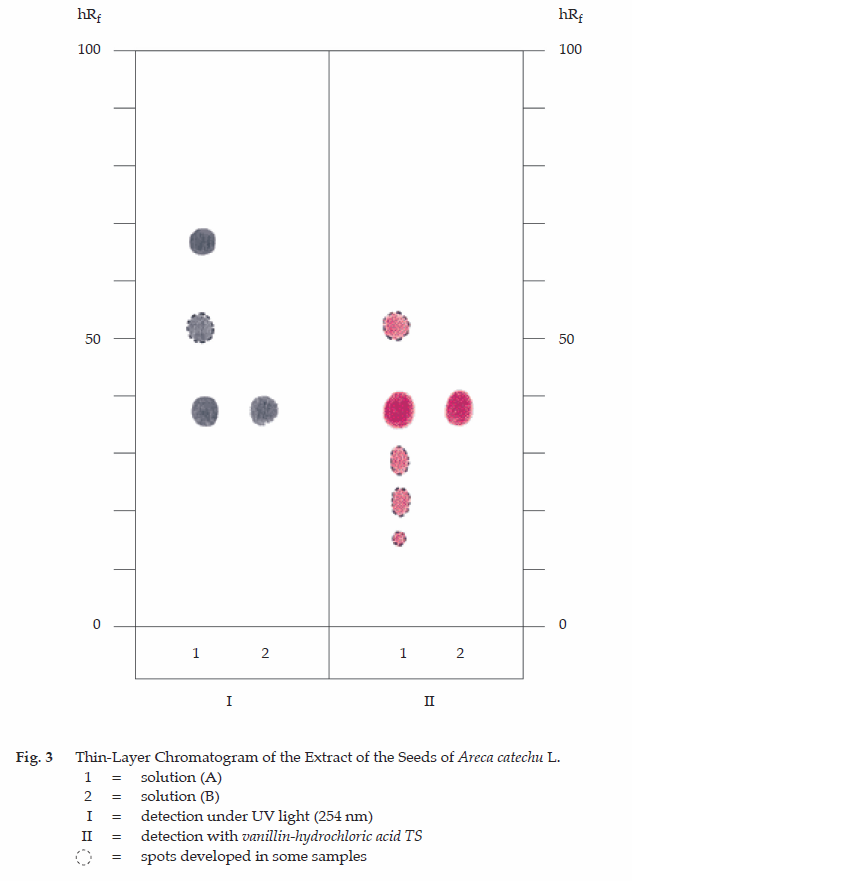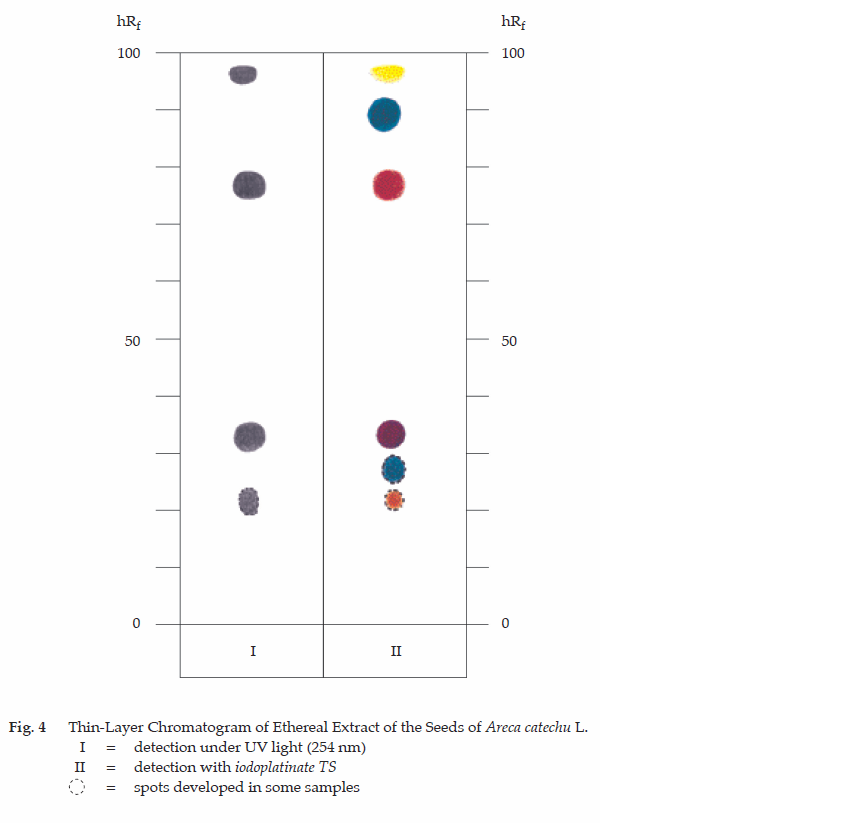ตำรามาตรฐานยาสมุนไพรไทย
Thai Herbal Pharmacopoeia
สำนักยาและวัตถุเสพติด กรมวิทยาศาสตร์การแพทย์ กระทรวงสาธารณสุข
Bureau of Drug and Narcotic, Department of Medical Sciences, Ministry of Public Health(Tinospora crispa (L.) Hook.f. & Thomson)
(Nelumbo nucifera Gaertn.)
(Centella asiatica (L.) Urb.)
(Centella Dry Extract)
(Centella Cream)
(Mesua ferrea L.)
(Piper sarmentosum Roxb.)
(Piper sarmentosum Roxb.)
(Pterocarpus santalinus L. f.)
(Santalum album L.)
(Senna tora (L.) Roxb.)
(Senna alata (L.) Roxb.)
(Senna Alata Tea)
(Piper retrofractum Vahl)
(Myristica fragrans Houtt)
(Andrographis paniculata (Burm. f.) Nees)
(Andrographis Capsules)
(Allium ascalonicum L.)
(Ocimum tenuiflorum L.)
(Curcuma longa L.)
(Turmeric Capsules)
(Turmeric Dry Extract)
(Turmeric Dry Extract Capsules)
(Arcangelisia flava (L.) Merr.)
(Curcuma sp.)
Harrisonia perforata (Blanco) Merr.
(Aristolochia pierrei Lecomte)
(Zingiber officinale Roscoe)
(Ginger Capsules)
(Ginger Tea)
(Cassia fistula L.)
(Nardostachys jatamansi (D. Don) DC.)
(Angelica sinensis (Oliv.) Diels)
Artemisia annua L.
(Ligusticum sinense Oliv. cv. Chuanxiong)
(Neopicrorhiza scrophulariiflora Pennell)
(Atractylodes lancea (Thunb.) DC.)
(Aucklandia lappa Decne)
(Terminalia chebula Retz.)
(Angelica dahurica (Hoffm.) Benth. & Hook. f. ex Franch. & Sav. var. dahurica)
(Kaempferia parviflora Wall. ex Baker)
(Hibiscus sabdariffa L.)
(Roselle Tea)
(Allium sativum L.)
(Zingiber zerumbet (L.) Sm.)
(Wurfbainia testacea (Ridl.) Škorničk.& A. D. Poulsen)
(Cannabis sativa L.)
(Myristica fragrans Houtt)
(Dracaena cochinchinensis (Lour.) S. C. Chen)
(Ficus racemosa L.)
(Hyptis suaveolens (L.) Poit.)
Clerodendrum indicum (L.) Kuntze
(Phyllanthus emblica L.)
(Citrus hystrix DC.)
(Citrus hystrix DC.)
(Areca catechu L.)
(Momordica charantia L.)
Moringa oleifera Lam.
(Aegle marmelos (L.) Corrêa)
(Solanum trilobatum L.)
(Morus alba L.)
Gynostemma pentaphyllum(Thunb.)
Makino
(Clinacanthus nutans (Burm. f.) Lindau)
(Cissus quadrangularis L.)
(Mimusops elengi L.)
(Zingiber montanum (J. König) Link. ex A. Dietr.)
(Piper betle L.)
(Capsicum annuum L.)
(Capsicum Oleoresin)
(Capsicum Gel)
(Piper nigrum L.)
(Piper nigrum L.)
(Eurycoma longifolia Jack)
(Thunbergia laurifolia Lindl.)
(Piper wallichii (Miq.) Hand.-Mazz.)
Senna garrettiana (Craib) H. S. Irwin & Barneby
(Terminalia bellirica (Gaertn.) Roxb.)
(Terminalia chebula Retz.)
(Caesalpinia bonduc (L.) H. Roxb.)
(Tarlmounia elliptica (DC.) H. Rob., S. C. Keeley, Skvaria & R. Chan)
(Hog Creeper Vine Dry Extract Capsiles)
(Hog Creeper Vine Dry Extract)
(Brachypterum scandens (Roxb.) Miq.)
(Lepidium sativum L.)
(Nigella sativa L.)
(Cuminum cyminum L.)
(Foeniculum vulgare Mill.)
(Plantago ovata Forssk.)
(Pimpinella anisum L.)
(Carum carvi L.)
(Anethum graveolens L.)
(Trachyspermum ammi (L.) Sprague)
Albizia procera (Roxb.) Benth.
(Acorus calamus L.)
(Tiliacora triandra (Colebr.) Diels)
Cyanthillium cinereum (L.) H. Rob.
(Orthosiphon aristatus (Blume) Miq.)
Murdannia loriformis (Hassk.) R. S. Rao & Kammathy
(Capparis micracantha DC.)
(Chrysopogon zizanioides (L.) Roberty)
(Cyperus rotundus L.)
(Cannabis sativa L.)
(Syzygium aromaticum (L.) Merr. & L. M. Perry)
(Boesenbergia rotunda (L.) Mansf.)
(Acanthus ebracteatus Vahl)
(Acanthus ilicifolius L.)
(Kaempferia galanga L.)
(Curcuma comosa Roxb.)
Betula alnoides Buch.-Ham. ex D. Don
Cannabis sativa L.
Carthamus tinctorius L
Mitragyna speciosa (Korth.) Havil
Mallotus repandus (Rottler) Müll. Arg
Azadirachta indica A. Juss. var. siamensis Valeton
Azadirachta indica A. Juss. var. siamensis Valeton
Punica granatum L.
Rhinacanthus nasutus (L.) Kurz
Baliospermum solanifolium (Burm.) Suresh
Curcuma aeruginosa Roxb
Boesenbergia kingii Mood & L. M. Prince
Senegalia rugata (Lam.) Britton & Rose
Acacia concinna (Willd.) DC.
Senegalia rugata (Lam.) Britton & Rose
Acacia concinna (Willd.) DC.
Senna alexandriana Mill. var. alexandriana
Cassia acutifolia Delile, Cassia angustifolia Vahl
Butea superba Roxb. ex Willd.
[Plaso superba (Roxb. ex Willd.) Kuntze, Rudolphia superba (Roxb. ex Willd.) Poir.
Pueraria candollei Graham
ex Benth. var. mirifica (Airy Shaw & Suvat.) Niyomdham
Streblus asper Lour.
Suregada multiflora (A. Juss.) Baill. (Gelonium
multiflorum A. Juss.
Areca Seed is the dried seed of reddish orange mature fruit of Areca catechu L. (Family Palmae), Herbarium Specimen Number: DMSC 1089.
Constituents Areca Seed contains the major alkaloid arecoline and other minor alkaloids which are arecolidine, arecaine (arecaidine), guvacine, guvacoline and isoguvacine. It also contains condensed tannins, (+)-catechin, (-)-epicatechin, fatty acids, amino acids, etc.
Description of the plant (Figs. 1a, 1b) Small to medium-sized tree up to 30 m tall; trunk solitary, straight, annulate, usually about 50 cm in circumference, uniformly thick. Leaves pinnate, 1 to 2 m long; petiole base expanding into a smooth, outside green, amplexicaul sheath, 75 to 100 cm long; leaflets numerous, 30 to 60 cm long, upper confluent glabrous, attached to the rachis in a vertical line. Inflorescence spadix, much branched, bearing male and female flowers; peduncle up to 60 cm long; rachis stout, compressed, branches with filiform tips. Male flowers numerous, sessile, without bracts, occupying the upper portion of the spikes; calyx 1-leaved, small, 3-cornered, 3-parted; petals 3, oblong, rigid, striated; stamens 6, anther sagittate. Female flowers much larger, solitary, or 2 to 3, at or near the base of each ramification of the spadix, sessile, without bracts; sepals 3, cordate, rigid, fleshy, permanent; petals 3, sepaloid, permanent; staminodes 6, connate; style scarcely any; stigmas 3, short triangular. Fruit glabrous, ovoid or ellipsoid, 3 to 7 cm long, orange or scarlet when ripe, supported by the persistent perianth, mesocarp fibrous. Seed 1, globose with truncate base; endosperm deeply ruminate; embryo basilar.
Description Odour, slight, characteristic; taste, astringent.
Macroscopical (Fig. 1a) Oblate or rounded-conical, 1.5 to 3.5 cm long, base 1.5 to 3 cm wide. Externally pale yellowish brown or pale reddish brown, with slightly concaved reticulate furrows, having a round, hollow micropyle in the centre of the base, beside which bearing an obvious scar-shaped hilum. Texture hard, uneasily broken; fractured surface showing marble-like striations alternated with brown seed coats and white endosperm.
Microscopical (Figs. 2a, 2b) Transverse section of the seed shows testa, several loosely packed layers of reddish brown cells with moderately thickened walls with a few scattered, small, rounded or slit-shaped pits. Testa rumination, several layers of large, pitted thin-walled cells, some of them filled with brown pigment and fixed oil globules, embedded with groups of vessels. Endosperm, large polygonal cells with beaded and porous cellulose walls, perforated by rounded to oval, conspicuous pits containing fixed oil globules and aleurone grains, some with rather smooth walls. Embryo, occupying the central region of the seed near the base.
Areca Seed in powder possesses the diagnostic microscopical characters of the unground drug.
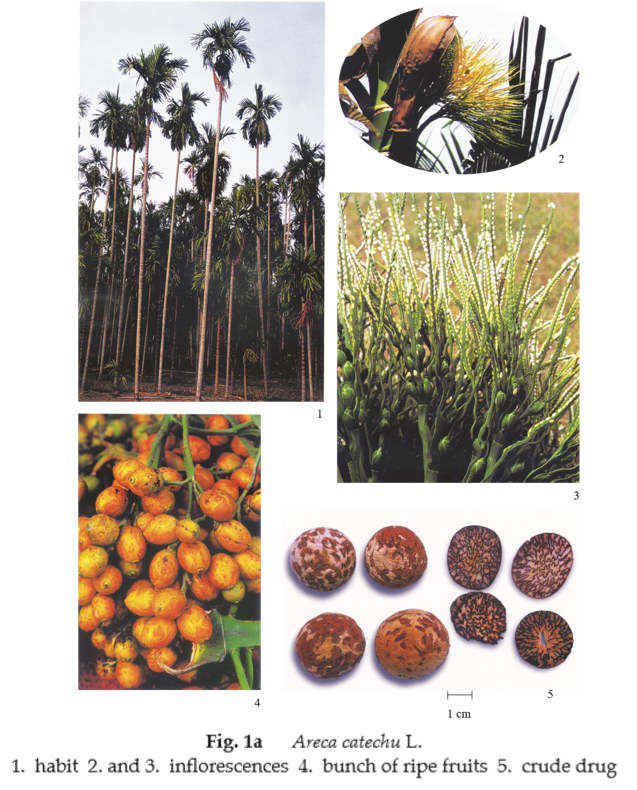
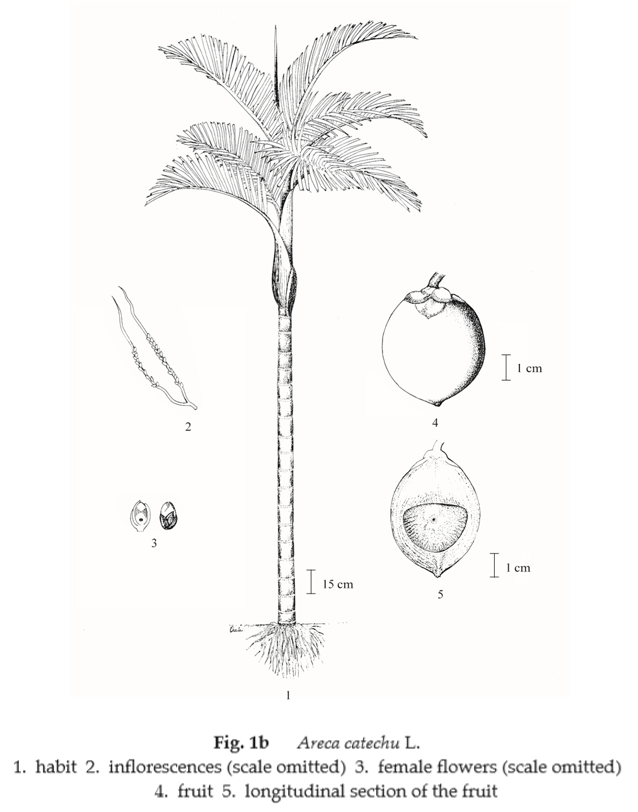
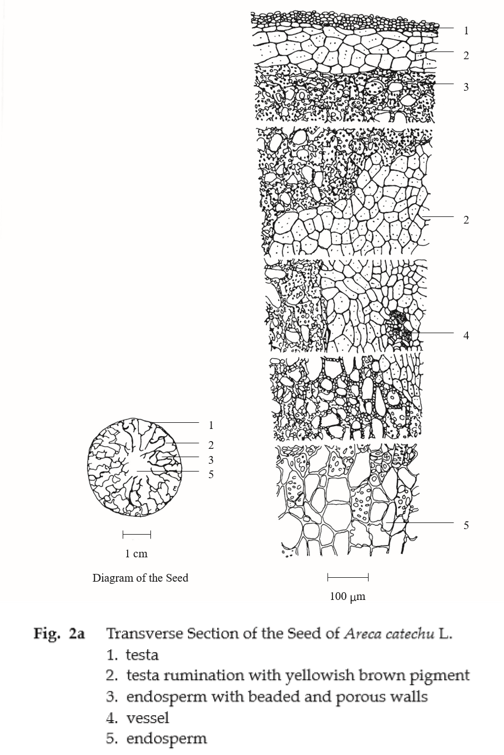
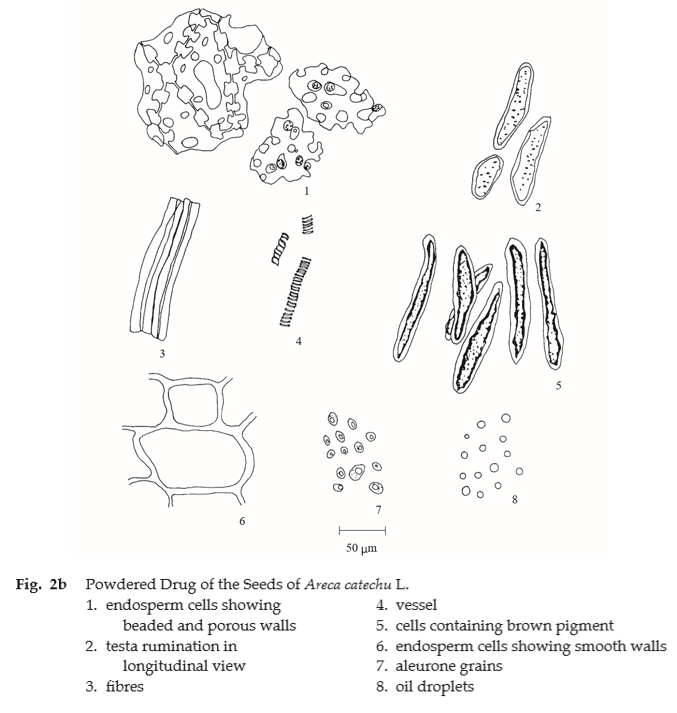
Packaging and storage Areca Seed shall be kept in well-closed containers, protected from light, and stored in a dry place.
Identification
A. Macerate 1 g of the sample, in powder, with 20 mL of water for 15 minutes and filter. Dip a wooden stick in the filtrate for a few seconds and dry at room temperature. Dip again in hydrochloric acid, remove immediately and dry: the wooden stick stains red.
B. To 100 mg of the sample, in powder, add 25 mL of water, heat in a water-bath for 5 minutes and filter. To the filtrate add 2.5 mL of hydrochloric acid and 5 mL of formaldehyde solution and warm: a pale brown precipitate is produced. Cool and filter. To 5 mL of the filtrate, add 2.5 g of sodium acetate and 0.5 mL of iron(III) chloride TS, and shake well: a reddish brown colour is produced which does not change to blue.
C. Macerate 1 g of the sample, in powder, with 10 mL of water for 10 minutes and filter. To 2 mL of the filtrate, add a few drops of a 5 per cent w/v solution of iron(III) chloride, and then make slightly alkaline with a 4 per cent w/v solution of sodium hydroxide: the colour is changed from dark green to purple.
D. Reflux 1 g of the sample, in powder, with 20 mL of chloroform in a water-bath for 15 minutes and filter. Evaporate 2 mL of the filtrate to dryness and dissolve the residue in 2 mL of acetic anhydride. Carefully add 1 mL of sulfuric acid to form a layer: a brown colour develops at the zone of contact and the colour of the upper layer changes from violet to blue and finally to yellowish-green.
E. Moisten 2 g of the sample, in powder, with 2 mL of strong ammonia solution, add 20 mL of ether, shake well, set aside for 1 hour, and filter. Dry the filtrate over anhydrous sodium sulfate, filter, and evaporate to dryness. Dissolve the residue in 4 mL of ethanol (solution 1). To 1 mL of solution 1, add a few drops of mercuric-potassium iodide TS: a white precipitate is produced. To 1 mL of solution 1, add a few drops of modified Dragendorff TS2: a precipitate is produced.
F. Carry out the test as described in the “Thin-Layer Chromatography” (Appendix 3.1), using silica gel GF254 as the coating substance and a mixture of 75 volumes of benzene, 25 volumes of methanol and 1 volume of formic acid as the mobile phase and allowing the solvent front to ascend 12 cm above the line of application. Apply separately to the plate, 20 μL each of the following solutions. Prepare solution (A) by boiling 500 mg of the sample, in powder, with 50 mL of water for a few minutes and filtering. Allow the filtrate to cool and shake with 30 mL of ether. Dry the ether layer over anhydrous sodium sulfate, filter, evaporate to dryness, and dissolve the residue in 1 mL of ethanol. For solution (B), dissolve 2 mg of catechin in 1 mL of ethanol. After removal of the plate, allow it to dry in air, and examine under ultraviolet light (254 nm), marking the quenching spots. The chromatogram obtained from solution (A) shows a quenching spot (hRf value 31 to 36) corresponding to the catechin spot from solution (B); other one or two spots are also observed (Table 1); see also Fig. 3. Spray the plate with vanillin-hydrochloric acid TS; the spot due to catechin is dark pink. Several other pink spots may appear (Table 1); see also Fig. 3.
Repeat the same procedure but use a mixture of 70 volumes of toluene, 20 volumes of ethyl acetate and 10 volumes of diethylamine as the mobile phase. Apply to the plate, 15 μL of solution 1 obtained from test E. After removal of the plate, allow it to dry in air, and examine under ultraviolet (254 nm), marking the quenching spots. The chromatogram shows three to four quenching spots (Table 2); see also Fig. 4. Spray the plate with iodoplatinate TS; several spots of different colours are observed (Table 2); see also Fig. 4.
Table 1 hRf Values of Components in the Extract of the Seeds of Areca catechu L.
| Spot | hRf Value | Detection | |
| UV 254 | Vanillin-Hydrochloric Acid TS | ||
| 1 2 3 4* 5 6 |
13-15 19-22 24-29 31-36 49-52 62-65 |
- - - quenching quenching quenching |
pale pink pale pink pale pink dark pink pale pink - |
*catechin
Table 2 hRf Values of Components in Ethereal Extract of the Seeds of Areca catechu L.
| Spot | hRf Value | Detection | |
| UV 254 | Iodoplatinate TS | ||
| 1 2 3 4 5 6 |
20-23 25-28 33-37 73-77 87-91 95-97 |
quenching - quenching quenching - quenching |
dark orange blue wine-red scarlet blue yellow |
Loss on drying Not more than 12.0 per cent w/w (Appendix 4.15).
Foreign matter Not more than 2.0 per cent w/w (Appendix 7.2).
Acid-insoluble ash Not more than 1.0 per cent w/w (Appendix 7.6).
Total ash Not more than 2.0 per cent w/ w (Appendix 7.7).
Ethanol-soluble extractive Not less than 25.0 per cent w/w (Appendix 7.12).
Water-soluble extractive Not less than 20.0 per cent w/w (Appendix 7.12).
Hexane-soluble extractive Not less than 0.5 per cent w/w (Appendix 7.12H).
Alkaloids content Not less than 0.5 per cent w/w of alkaloids, calculated as arecoline, when determined by the following method.
Place 8 g of Areca Seed, in coarse powder, accurately weighed, in a conical flask with a stopper, add 80 mL of ether and shake. Add 4 mL of ammonia TS, shake for 10 minutes, add 10 g of anhydrous sodium sulfate, shake again for 5 minutes and allow to stand and precipitate. Transfer the ether solution to a separator, wash the residue with three successive 10-mL portions of ether. Combine the ether solutions, add 500 mg of talc, shake for 3 minutes, add 2.5 mL of water, and then shake for 3 minutes. Allow to stand until the supernatant ether solution is clear. Separate the ether solution, wash the aqueous layer with a small quantity of ether, combine the ether solutions and evaporate to about 20 mL at low temperature. Transfer to a separator, carefully add 20.0 mL of 0.01 M sulfuric acid VS, shake and allow to stand. Separate the ether layer, wash with three successive 5-mL portions of water. Combine the washings and the acid solution, filter, and wash the filter with water. Combine the washings and the acid solution, add several drops of methyl red TS, and titrate with 0.02 M sodium hydroxide VS. Perform a blank determination (Residual Titrations, Appendix 6.17). Each mL of 0.01 M sulfuric acid VS is equivalent to 3.104 mg of arecoline (C8H13NO2).
Tannins content Not less than 24.0 per cent w/w (Appendix 7.21 H). Use 4 g of Areca Seed, in powder, accurately weighed.
